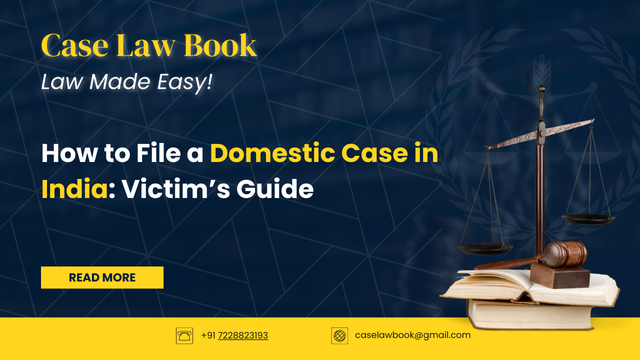Domestic violence is a pervasive issue that affects individuals of all genders, ages, and socioeconomic backgrounds. It’s crucial to remember that no one deserves to be subjected to any form of abuse, whether physical, emotional, or financial. If you are experiencing domestic violence, know that you are not alone, and help is available. This guide provides a general overview of how to File a Domestic Violence Case in India, empowering victims with the knowledge to seek legal recourse and protect themselves.
Understanding Domestic Violence: Beyond Physical Abuse
Domestic violence, as defined under the Protection of Women from Domestic Violence Act, 2005, encompasses more than just physical violence. It includes under Section 3:
- Physical Abuse: Any act that causes physical pain, injury, or harm.
- Emotional/Verbal Abuse: Insults, threats, intimidation, and constant criticism that cause emotional distress.
- Sexual Abuse: Any unwanted sexual contact, including marital rape.
- Financial Abuse: Controlling finances, withholding money, or preventing access to resources.
- Economic Abuse: Depriving the person of their economic resources or means.
Steps to Take When Experiencing Domestic Violence:
- Prioritize Safety: Your immediate safety is paramount. If you are in immediate danger, remove yourself from the situation and seek a safe place.
- Seek Medical Attention: If you have sustained any injuries, seek medical attention immediately. Medical records serve as crucial evidence in a File a Domestic Violence Case in India.
- Gather Evidence: If possible, collect any evidence of the abuse, such as photos of injuries, recordings of verbal abuse, or documentation of financial control. This evidence will be vital when you File a Domestic Violence Case in India.
- Reach Out for Support: Talk to a trusted friend, family member, or counselor. Sharing your experience can be the first step towards healing and seeking help.
How to File a Domestic Violence Case in India: A Step-by-Step Guide
The process to File a Domestic Violence Case in India can seem daunting, but understanding the steps involved can make it less intimidating:
- Approach the Police: You can file a First Information Report (FIR) at the nearest police station. While the police are obligated to register the FIR, sometimes they may be hesitant, especially in cases of domestic violence. It is important to be assertive and insist on filing the FIR and as per the duty of Police under section 5, they’re bound to inform you about:
- right to make an application for obtaining a relief by way of a protection order, an order for monetary relief, a custody order, a residence order, a compensation order or more than one such order under the Act;
- the availability of services of service providers;
- the availability of services of the Protection Officers;
- right to free legal services under the Legal Services Authorities Act, 1987 (39 of 1987);
- right to file a complaint under section 498A of the Indian Penal Code (45 of 1860),wherever relevant.
You may also approach the shelter homes and medical facilities taking assistance from the Protection Officers.
- Contact a Lawyer: Consulting with a lawyer specializing in domestic violence cases is crucial. A lawyer can guide you through the legal process, explain your rights, and represent you in court. They can also draft the complaint for you to File a Domestic Violence Case in India effectively.
Don’t be afraid of telling anything and tell everything which is required for the case. If you cannot afford a lawyer then you may also go for free legal aid.
- File a Complaint with the Magistrate: You can also file a complaint directly with the Magistrate under the Protection of Women from Domestic Violence Act, 2005. This Act provides for various reliefs, including protection orders, residence orders, monetary compensation, and custody orders. Your lawyer can help you draft and file the complaint.
- Approach a Protection Officer: Protection Officers are appointed by the government to assist victims of domestic violence. They can provide you with information about your rights, help you file a complaint, and connect you with support services.
- Proceedings: The proceedings for the same will be held in camera.
Legal Provisions and Rights:
The Protection of Women from Domestic Violence Act, 2005, is a landmark legislation that provides legal protection to victims of domestic violence in India. It recognizes various forms of abuse and provides for a range of reliefs, including:
- Protection Orders: Restraining the abuser from committing any further acts of violence.
- Residence Orders: Allowing the victim to reside in the shared household, even if it is owned by the abuser.
- Monetary Compensation: Ordering the abuser to pay compensation for the physical, emotional, and financial harm caused.
- Custody Orders: Granting the victim custody of their children.
Important Considerations:
- Confidentiality: The law ensures the confidentiality of the victim’s identity, ensuring that at no point their identity is revealed.
- Right to Legal Aid: Victims of domestic violence are entitled to free legal aid.
- Time Limit: There is no specific time limit for filing a complaint under the Protection of Women from Domestic Violence Act.
Supporting Resources:
Several NGOs and government organizations provide support services to victims of domestic violence, including helplines, counseling, and shelter homes.
Summary:
Domestic violence is a serious crime, and victims have the right to seek legal recourse. This guide provides a general overview of how to File a Domestic Violence Case in India. Remember, you are not alone, and help is available. Taking the first step towards seeking help can be empowering and life-changing.
Also read :Bulldozer Justice: Is It Justice or Just a Show?
